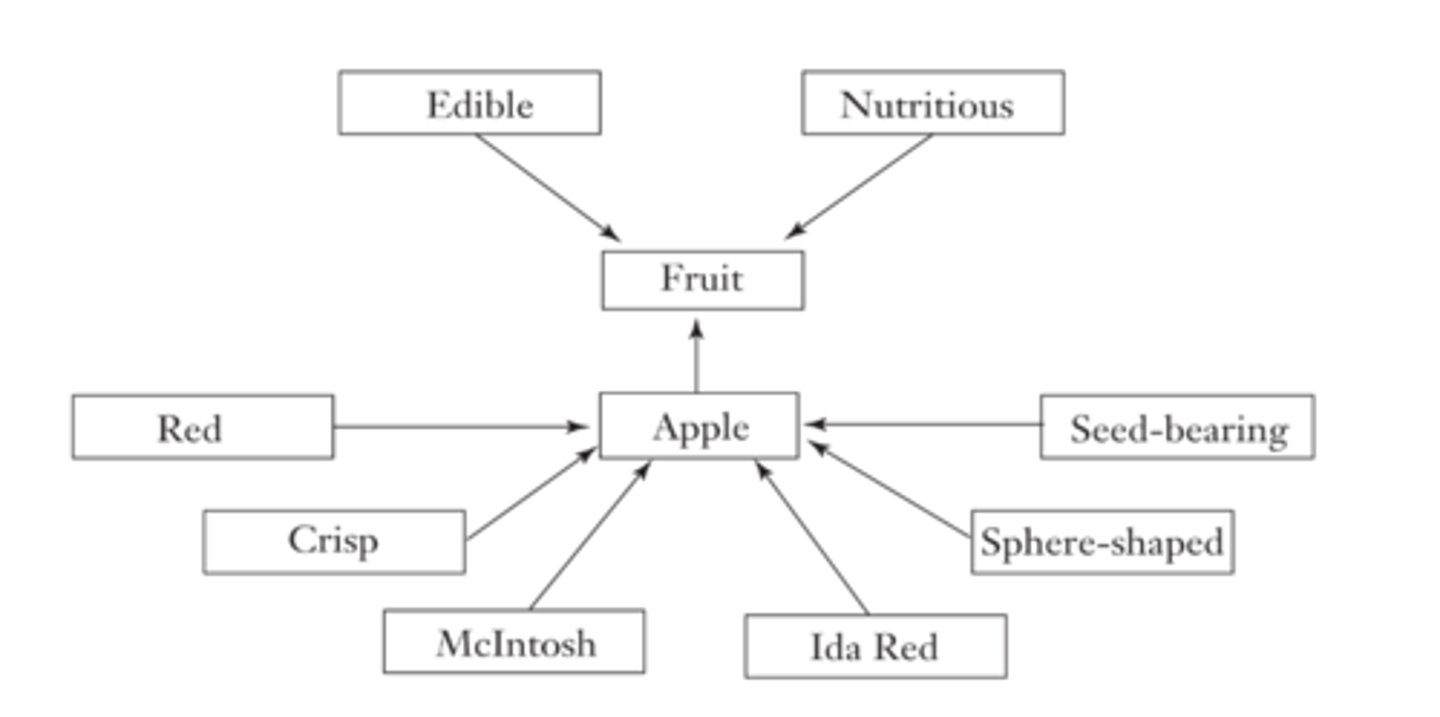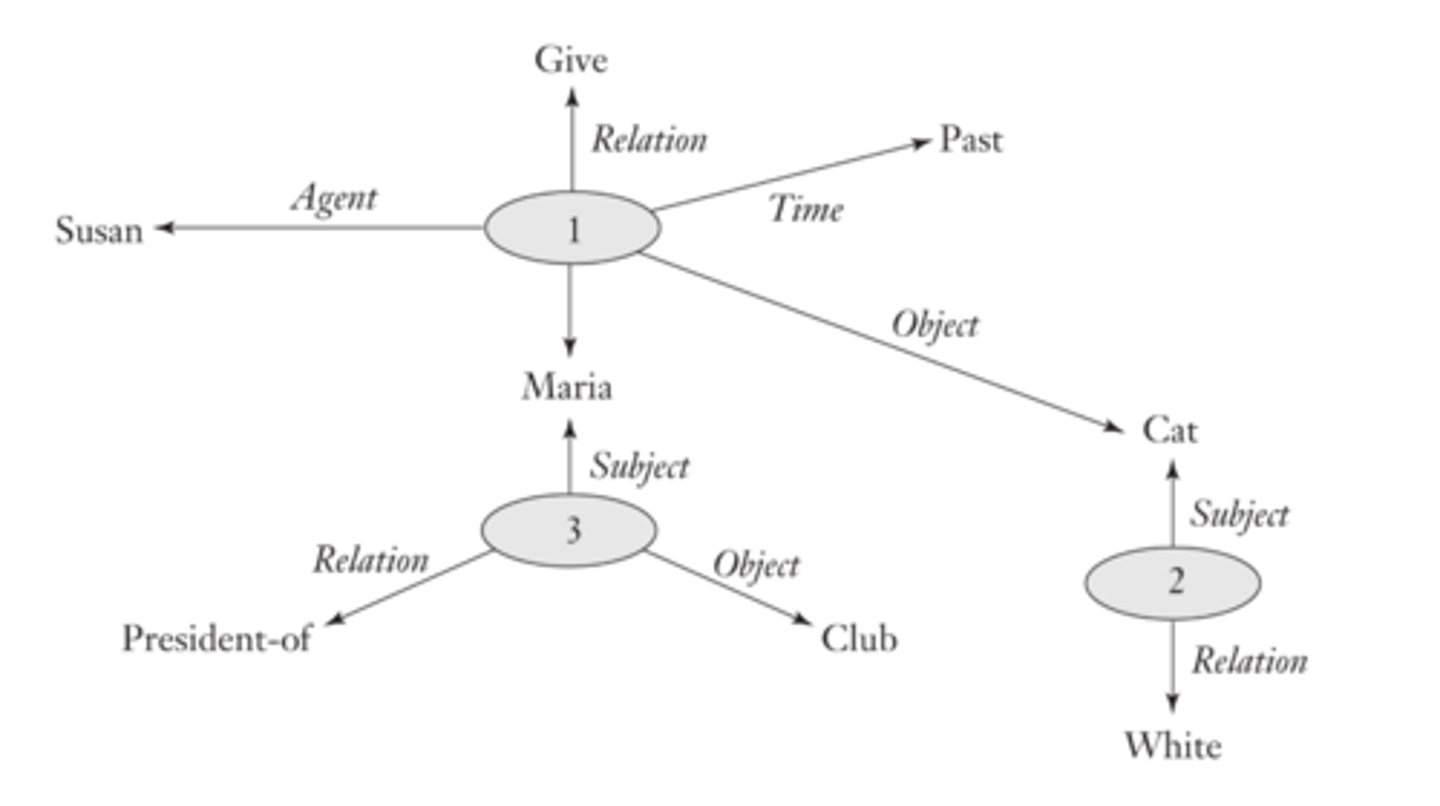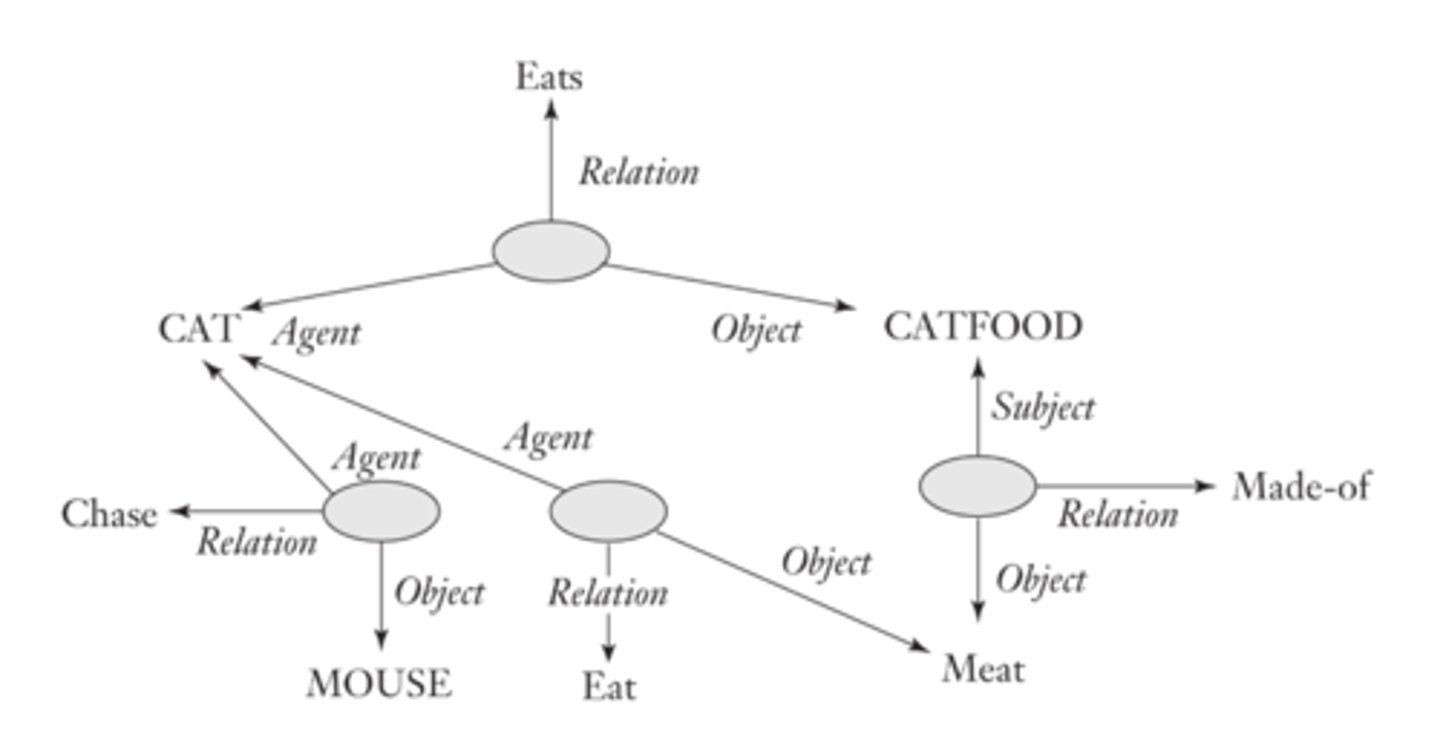Cognitive Psychology (8) - General Knowledge
1/58
There's no tags or description
Looks like no tags are added yet.
Name | Mastery | Learn | Test | Matching | Spaced |
|---|
No study sessions yet.
59 Terms
Inference
Refers to the logical interpretations and conclusions that were never part of the original stimulus material.
General knowledge allows you to go beyond a ...
verbatim interpretation of the stimulus by making inferences or by making predictions about other similar stimuli.
Semantic Memory
Our organised knowledge about the world (ex. "Tegucigalpa is the capital of Honduras.")
Episodic Memory
Information about events that happen to us (ex. "This morning in my Political Science course, I learned that Tegucigalpa is the capital of Honduras.")
What forms of knowledge does semantic memory include?
General knowledge, lexical/language knowledge, conceptual knowledge.
What are essential components of semantic memory?
Categories and concepts.
Category
A set of objects that belong together (that are at least partly equivalent; "fruit").
Concept
Mental representations of a category.
Concepts are useful because they allow you to ...
make numerous inferences when you encounter new examples from a category.
Situated Cognition Approach
We make use of information in the immediate environment or situation.
Prototype
An item that is the best, most typical example of a category.
Rosch's Prototype Approach
You decide whether a particular item belongs to a category by comparing this item with a prototype.
What is an example of the prototype approach?
You would conclude that a robin is a bird because it matches your ideal prototype for a bird. A bee would be placed in a different category "insects".
Prototypicality
The degree to which they are representative of their category (robins and sparrows which are prototypical, compared to ostriches and penguins).
A category tends to have a graded structure, which begins with ...
the most representative or prototypical members, and it continues on through the category's nonprototypical members.
Prototypes differ from nonprototypical members of categories in three major aspects:
(1) Prototypes are supplied as examples of a category.
(2) Prototypes are judged more quickly than nonprototypes, after semantic priming.
(3) Prototypes share attributes in a family resemblance category.
Typicality Effect
Occurs when people judge typical items (prototypes) faster than items that are not typical (nonprototypes); when judging whether items belong to the category "bird", people judge robin more quickly than penguin.
Semantic Priming Effect
People respond faster to an item if it was preceded by an item with similar meaning.
Family Resemblance
No single attribute is shared by all examples of a concept; however, each example has at least one attribute in common with some other example of the concept (essentially overlapping features).
Superordinate-Level Categories
More general categories (ex. "furniture", "animal", "tool")
Basic-Level Categories
Moderately specific (ex. "chair", "dog", "screwdriver")
Subordinate-Level Categories
More specific categories (ex. "desk chair", "collie", "Philips screwdriver")
What are the three reasons that form the special status of basic-level categories?
(1) Identifying objects (people prefer to use basic-level names and respond faster to it).
(2) More likely to produce the semantic priming effect (due to mental representation).
(3) Different levels of categorisation activate different regions of the brain.
What are the downsides of the prototype approach?
(1) Concepts can be unstable and variable as time passes and context changes.
((2) We often store specific information about individual examples of a category.
Exemplar Approach
We first learn information about some specific examples of a concept; we then classify each new stimulus by deciding how closely it resembles all of those specific examples.
Exemplar
Each example stored in memory.
Collins and Loftus Network Model
Propose a netlike organisation of concepts in memory, with many interconnections; when we retrieve information, activation spreads to related concepts.

Node
Location in the network.
Spreading Activation
The activation expands or spreads from that node to other nodes with which it is connected.
Collins and Loftus also proposed that frequently used links have ...
greater strength; activation travels faster between the nodes (explains the typicality effect).
ACT-R ("Adaptive Control of Thought-Rational")
Uses a series of network models in an attempt ot account for a wide variety of tasks including memory, learning, spatial cognition, language, reasoning, problem solving, and decision making.
Declarative Knowledge
Knowledge about facts and things; differs from semantic memory because it is more general.
Propositional Network
A pattern of interconnected propositions (ex. "Susan gave a white cat to Maria, who is the president of the club.")

Proposition
Smallest unit of knowledge that people can judge to be either true or false (ex. "The cat was white.")
Anderson also suggested that each of the concepts in a proposition ...
can be represented by its own individual network.

Parallel Distributed Processing (PDP) Approach
Cognitive processes can be represented by a model in which activation flows through networks that link together a large number of simple, neuron-like units.
The PDP approach emphasises that we should represent concepts in terms of ...
networks, rather than specific locations in the brain.
What are four general characteristics of the PDP approach?
(1) Based on parallel operations.
(2) Basic neuron-like units or nodes, which are connected together.
(3) Spreading activation.
(4) The current context often activates only certain components of a concept's meaning.
Spontaneous Generalisation
Using individual cases to draw inferences about general information (we draw a conclusion about a general category).
Default Assignment
Filling in missing information about a particular person or object by making a best guess (we draw a conclusion about a specific member of a category).
Graceful Degradation
The brain's ability to provide partial memory.
Schema
Generalised, well-integrated knowledge about a situation, event, or a person.
Connection Weights
Characteristic of neural networks that determines how much activation one unit can pass on to another unit.
Script
Simple, well-structured sequence of events that usually occur in a specified order (associated with highly familiar activity).
Life Script
A list of events that a person believes would be most important throughout their lifetime.
Boundary Extension
Our tendency to remember having viewed a greater portion of a scene than was actually shown.
Abstraction
A memory process that stores the meaning of a message, rather than the exact words.
Verbatim Memory
Word-for-word recall.
False Alarm
When people "remember" an item that was not originally presented.
Constructive Model of Memory
People integrate information from individual sentences to construct larger ideas.
Pragmatic View of Memory
People pay attention to the aspect of a message that is most relevant to their current goals.
Memory Integration
Our background knowledge encourages us to take in new information in a schema-consistent fashion.
What is a downside of the exemplar approach, and when is it suitable?
Our semantic memory would quickly become overpopulated with numerous exemplars for numerous categories; it is best suitable for a category with relatively few members.
The prototype approach may be more suitable when considering ...
a category that has numerous members (ex. "fruit" or "animal").
What are four theoretical features important in the PDP approach?
1. Connection weights determine how much activation one unit can pass on to another unit; as you learn more information, the values of these weights will change.
2. When a unit reaches a critical level of activation, it may affect another unit by exciting/inhibiting it.
3. Each new experience with a particular item will change the strength of connections among relevant units by adjusting the connection weights.
4. Sometimes we only have partial memory for some information.
Schema theories propose that our memories ...
encode "generic" information about a situation; we then use this information to understand and remember new examples of the schema.
Research demonstrates that people recall a script significantly more accurately if ...
the script has been clearly identified in advance.
What are the four trends seen in schemas?
1. People tend to remember information accurately when it is consistent with a schema (minor event, limited time).
2. People do not remember information that is inconsistent with the schema (minor event, limited time).
3. People rarely create a completely false memory for a lengthy event that did not occur.
4. When the information describes a major event that is inconsistent with the standard schema, people are likely to remember that event.
Schemas can influence our memory when ...
we are reading ambiguous or unclear material.